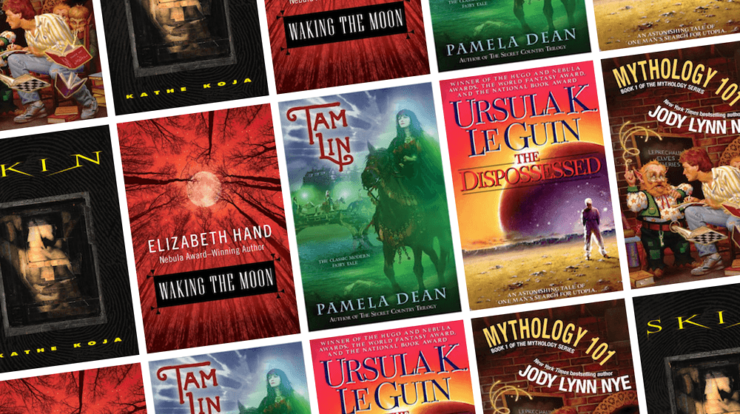My family moved to Toronto when I was fourteen. At the time, there was still a fifth year of high school required, a series of courses that involved lengthy essays and independent projects. The idea that I’d be graduating a year after my friends back in New York bothered me, and I determined that I would cram the fifth year into the fourth. I’d somewhere absorbed the idea that high school was hell and college (as well as anything else that came after) was better, and I should do everything I could to hasten the change.
Where had I gotten that idea? Nnedi Okorafor’s Binti wasn’t around yet, nor Diana Wynne Jones’ Year of the Griffin, nor Lev Grossman’s The Magicians, nor Terry Pratchett’s Unseen Academicals. Here are five of the books that may have contributed to my rush to leave high school behind.
Mythology 101 by Jody Lynne Nye
Mythology 101 is exactly the kind of funny fantasy I adored at fourteen. Earnest student Keith Doyle discovers elves living in his university library. Libraries are magical, so it makes perfect sense that university libraries are even more magical. This one had FOURTEEN levels of stacks in addition to the four floors of the library. That was just the part people knew about! Secret spaces have always been my jam: Give me hidden floors, hidden rooms, mystery staircases, tunnels, catacombs. I’d happily have lived in the Gillington Library.
Buy the Book
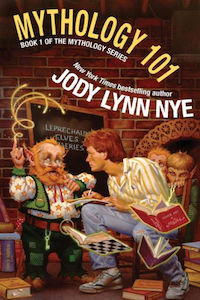

Mythology 101
Waking the Moon by Elizabeth Hand
Waking the Moon starts with a place-setting:
I met them in Magic, Witchcraft, and Religion. A fitting place, that magician’s grove within the enchanted forest that was the Divine…even though there only seven of us students, and the dyspeptic rathators hissed as though black winter gnawed at the stained glass windows, instead of the city’s sultry Indian summer.
We’re one paragraph in, and this school already has it all: small classes, stained glass, classes on magic. And that name: The University of the Archangels and Saint John the Divine. And that motto: Vita, sine literis, mors est. Life without learning is death. “Long-haired sunburned girls in puckered cotton sundresses” join “long-haired boys who pulled clinking green bottles from a cooler and toasted each other in sure, joyous cadences.” The protagonist’s dorm room is “a surprisingly comfortable haven” in Rossetti Hall, “a huge and Gothic edifice, vine-hung, sweet with the carnal scent of wisteria blossoms.” That wasn’t too much to ask, surely.
The protagonist, Sweeney, makes friends with Oliver, he of the doomed matinee idol face, and the regal Angelica. Both of them make Sweeney feel shabby by comparison, but they rid her of the loneliness she had felt on arrival. On top of that, real magic, powerful magic, is afoot. Angelic visitations, flowering relics, visions, secret orders, a dangerous goddess…that all sounded about right to me.
Buy the Book
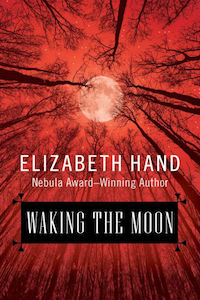

Waking the Moon
Tam Lin by Pamela Dean
If the Divine was an imposing institution, Tam Lin‘s Blackstock College was just the kind of place I was looking for after four years at a two thousand-student public high school. The main character, Janet, is the daughter of a Blackstock professor, so she already knows her way around. Even if she’s a little jaded, she can still appreciate her dorm building’s high ceilings, oak woodwork, natural light. She makes friends with her roommates, takes classes she’s interested in, falls for somebody who respects her, chats with her well-read classmates, and lives out an old ballad. The college and its attendees are great, never mind that the faculty includes the Queen of Elfland.
Buy the Book
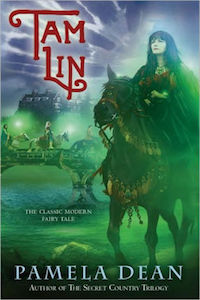

Tam Lin
The Dispossessed by Ursula K. Le Guin
This 1974 classic, part of Le Guin’s Hainish cycle, is the only noncontemporary book on my list. The planets Urras and Annares orbit each other as they revolve around a common star. Annares is mostly desert, and was settled by dissidents from Urras. The Annaresti are collectivist followers of Odo, in contrast with the propertarian Urrasti. The novel centers around an Annaresti physicist named Shevek who is the first from his planet to journey to Urras in over a century. Shevek doesn’t quite fit into either world—a feeling that spoke to me. At home his work isn’t considered important or necessary to the survival of the collective. He goes to the university on Urras, but discovers that they want to profit from his ideas. We see both societies through his eyes.
There are parts of both worlds that appealed to me as I thought about leaving home. The Annaresti dormitories seem like a great living situation, and the residents know how to throw an excellent party, with delicious food, rehearsed and impromptu entertainments, music, dancing, late night conversation, and single rooms for any couples who hit it off. The all-male university on Urras dulls by comparison, despite its luxury. Shevek was my kind of professor, rejecting the exam system, tests, and grades, and asking students to simply write papers on any problem in physics that piqued their curiosity. The Urrasti students wanted to know where they stood, but I could get behind Shevek’s methods.
Buy the Book


The Dispossessed
Skin by Kathe Koja
On the worst days of high school, college didn’t seem like it would be the escape I hoped for. Even though this isn’t a book set at an institution of higher learning, it fits the bill in terms of fiction that led me to believe there were better things in store. Koja is known as a horror writer, and there are horrific elements here, but this is a book about art and passion, and it was queer in a time when I was just learning what that meant to me.
Tess is a sculptor who works in scrap metal; Bibi is a performance artist whose body is her own canvas—artists taking art to extremes, written in Koja’s musical, visceral, liquid-metal style. Every sculpture came alive: “wings like knives, the churn of flayed metal sheet stock, the mouth all teeth like God’s own engine come back to earth to burn.” This is one of those books that successfully dances about architecture. If I couldn’t hack college, why not throw in my lot with an art collective? Though, uh, hopefully not this one.
Buy the Book
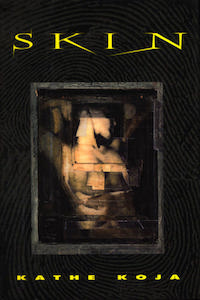

Skin
Sarah Pinsker‘s stories have won the Nebula and Sturgeon awards, and have been finalists for the Hugo, the Locus, and the Eugie Foster Memorial Award. Her first novel, Song For A New Day, will be published in autumn 2019. She is also a singer/songwriter with three albums on various independent labels and a fourth she swears will be released someday soon. She was born in New York and has lived all over the U.S. and Canada, but currently lives with her wife in Baltimore in a hundred-year-old house surrounded by sentient vines. Find her @sarahpinsker










